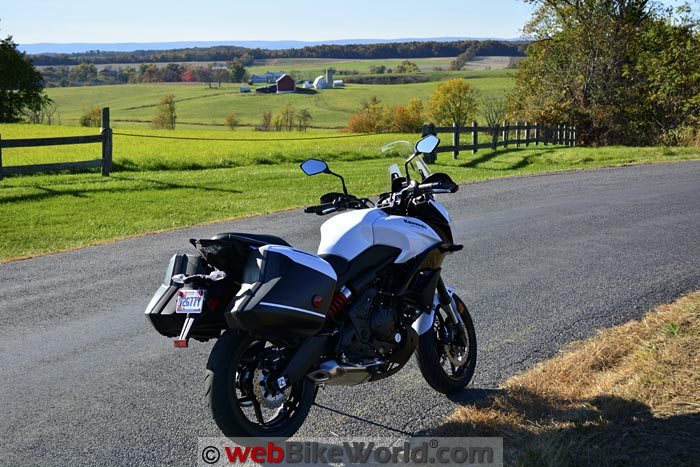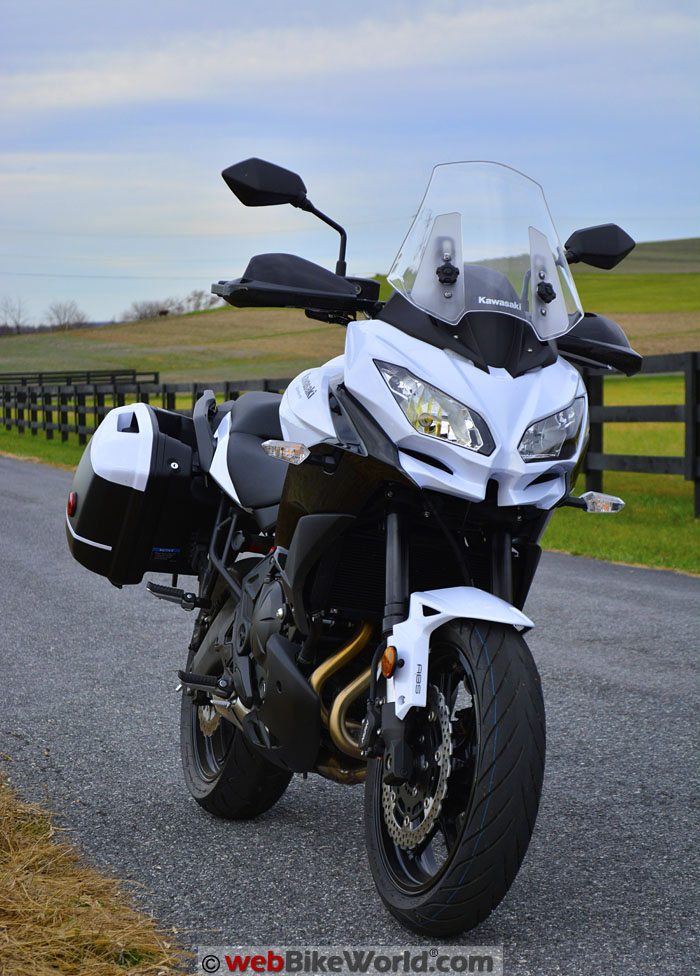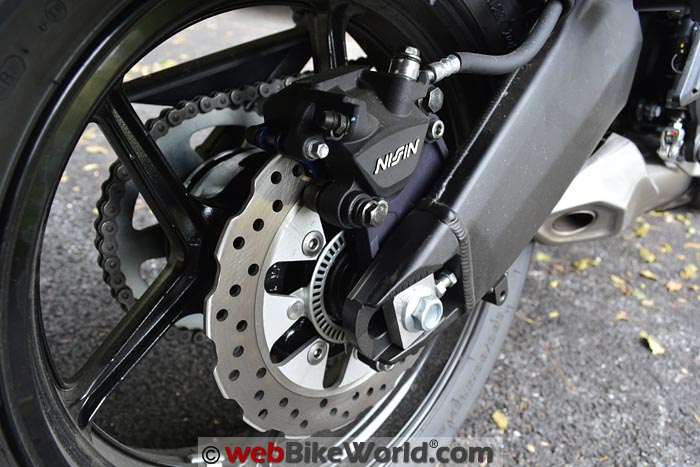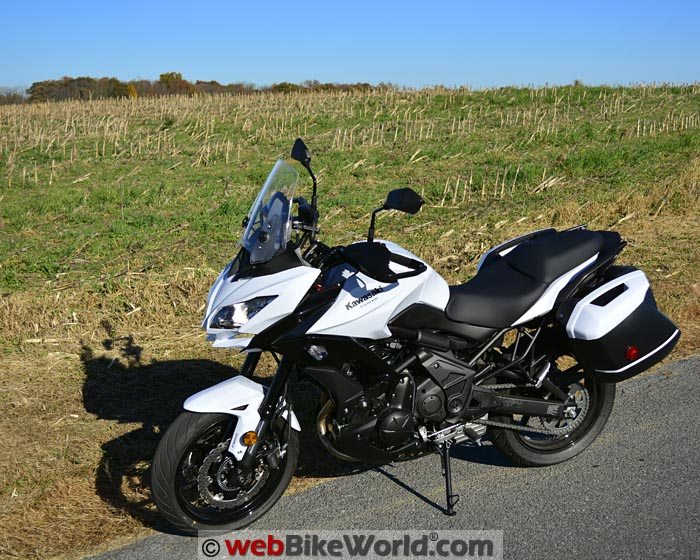Part 2: A Versys Mid-Term Report
Breaking in a new motorcycle can be a frustrating experience.
Example: The Versys 650 owner’s manual calls for a 4,000 RPM limit for the first 500 miles, then a 6,000 RPM limit from 500 to 1,000 miles.
That 4,000 RPM translates to about 52 MPH in 6th gear.
But that’s nothing compared to the Suzuki GW250 (Blog), which had a limit of 5,500 RPM for the first 500 miles.
With its 250cc high-revving engine, 5,500 RPM meant just 45 MPH max on a perfectly flat road.
A little headwind or a hill quickly threw cold molasses into the works and the average speed became more like 25 to 30 MPH.
Think about it: that poses a real problem just finding a road to cruise on where you won’t get crushed from behind.
I can tell you this: putz around for 500 miles at 30 MPH and you’ll be screaming for mercy in no time. Getting past the 1,000 mile break-in on that bike was torture.
It’s not quite as bad as that with the Versys at least, because larger engines generally have enough power to disguise the break-in limits, to a certain extent anyway.
But short-shifting the Versys at 4,000 RPM told me absolutely nothing about any muscle that might be lurking in the 650cc engine. And the transmission wasn’t too happy with short shifts either.
At around 50 miles average per ride — which is about all I could take at those break-in speeds — it took 10 days spread out over a few weeks just to move past the 500 mile first-phase limit.
It was a thrill to finally be able to gas it to 6,000 RPM in Phase 2 of the break-in, but that’s still just a touch over half-way to the 10,000 RPM redline.
Surprise! There’s a strong hint though that the 650cc engine punches above its weight; in fact, I think the Versys may actually feel faster than the BMW F800S (Blog) which has about 19% more cubes but weighs about 410 lbs. to the Versys LT’s 476 lbs.
So now that I’m at least half-way through the interminable break-in period, here’s my mid-term report on a few more details I’ve noticed, in no particular order.

Seat
I’m usually not all that fussy about motorcycle seats. In fact, I thought the stock seat on the 2014 Suzuki V-Strom 1000 ABS (Blog) is about as good as it gets, contrary to many owners.
It’s flat, wide and has enough room to move around, with no second thinking by designers trying to add stylish curves and humps all in the wrong places.
I didn’t have as much luck with the GW250 seat, which forced me down into the tank into a fairly excruciating riding position. That seat was the main reason the Inazuma left the webBikeWorld Project Bike lineup sooner, rather than later.
The seat on the Versys isn’t that bad at least, but it’s not as good as the V-Strom’s either.
Unlock the Versys seat and pull it off the bike and you’ll discover some Kawasaki cost-cutting. The cushion is about as basic as it gets; just a slab of cheap foam stapled to a plastic base.
The foam compresses too easily and I can feel the seat pan in some spots. Add in the top curvature of the foam and it hits me “right up under there”.
The sharp rise where the passenger “seat” begins (I don’t think anyone would want to sit on it for very long) kind of limits your wiggle room also.
Combine that with a slightly too short seat-to-foot-peg distance and a handlebar that’s about 50 mm too far forward and down, and the bottom line is about 1 hour of riding before the aches start.
For the record, I’m 5’10” (183 cm) with a 34″ (86 cm) street sleeve length and about a 31.5″ (80 cm) inseam wearing boots.
The good news? I think some of this can be corrected.
I’ve already ordered a handlebar riser that — supposedly — will fit with no control cable mods. Bonus: it has a removable (two screws) built-in GPS holder that — again supposedly — doesn’t interfere with the view of the instruments.
More on that after I’ve had a chance to mess with it, but if it works, it should help to put me in a slightly more upright riding position.
This may also help the handling, which I’ll get to in a minute, because it could reduce some weight from my upper body on the handlebar. The Versys can use that.
As for the seat, somewhere in my web travels I found a semi-custom 2015 Versys 650 seat replacement, but I’ll be twitched if I can find it again. Pretty expensive though at 650-odd bucks, so let’s see if the cheap fixes work first.

Throttle
I noticed quite a bit of slack in the throttle cable when the bike was on the dealer’s floor. I mentioned it and they addressed it before delivery.
But it quickly loosened after the first few miles and I promptly tightened it at the adjustment nut.
There still seems to be a bit too much play in the cable though and it doesn’t take long before it becomes too loose again. This is noticeable when I’m making a turn and want to blip the throttle during a downshift — the amount of play doesn’t allow smooth throttle blips.
I haven’t spent much time on this, because it’s a fairly minor issue and maybe the cable will continue to stretch a bit while the bike is still fairly new. I’ll try some more adjustment and maybe raise the idle speed a couple hundred RPM and see what happens.
Shifting
Still a little early to tell for sure, but so far, the Versys transmission feels pretty klunky (that’s a scientific word), especially compared to the very slick-shifting V-Strom.
I’ve never missed a shift on the Versys however, despite the short-shifting 4,000 RPM break-in limit, and it’s also very easy to find neutral, what with the “positive neutral finder” or whatever they call it built into the tranny.
But the 1, 2 and 3 upshifts and downshifts are old-school stiff and I definitely hear it whenever I move up or down past neutral; surely an artifact of that positive neutral finder thingie.
I also discovered that the 4, 5 and 6 upshifts only want just a very gentle touch, quite unlike the V-Strom and most of the other bikes I’ve ridden in the past 30 years or so.
In fact, the Versys is happiest with clutchless upshifts in those top 3 gears.
Put a bit of upward toe pressure on the shift lever, let off just a hair on the throttle and pull up with the toe and the transmission quietly and smoothly snicks (another scientific term) into gear.
It all takes some getting used to and I’m hoping things will improve after the first oil change and the RPM limit is gone.

Suspension
OK, now we’re getting into some of the more serious stuff that would be more difficult to fix.
The bottom line here is that Versys 650 suspension isn’t very sophisticated.
To compound matters — and like most new motorcycles today — the suspension is set up rock-hard, probably to satisfy the print magazine testers to whom anything that handles unlike a World Superbike ride isn’t worthy.
Every new bike we’ve had come through here in the past 16 years has a suspension that’s simply way too stiff for the street.
Unfortunately, most of the unwashed masses believe what they read in the print magazines, so when they feel 1 mm of front-end dip during hard braking, they think they’ve been had.
Not so folks; you want a lot of cush in that ride when you’re riding on the street. On the track stiff is OK, but not for the vast majority of street work.
The Versys was no different and the initial suspension setup is rock-hard according to Kawasaki delivery specs.
I kept tweaking it to find some relief and the result is that the the damping screw on the rear has been let out all the way and I have also backed out the rebound and compression on the forks (“preload” and “tension” in Kawasaki terminology) to nearly the end of the limit.
But I would still characterize the handling as “busy”.
On a smooth road, it’s fine, but get on to some typical secondary roads and the suspension just feels jiggly (yep, another scientific word), busy and bumpy. “Nervous” is how I would describe it.
I’m thinking once the handlebar riser arrives it may help, because that also helped on the V-Strom. A more upright riding position helps to take that upper body weight off the handlebar and that can make a difference. We’ll see…

Handling and Tires
The suspension bumpiness in rough-road corners certainly doesn’t help the handling of the Versys. But the #1 biggest issue I have with the bike is with the Dunlop D222 tires.
I’m “tire sensitive”, as anyone would be after riding as many bikes as come through here with as many different tires.
Why Dunlop ever allowed Kawasaki to slap on the D222 tires (120/70-17 front and 160/60-17 rear) is beyond me. Dunlop is doing themselves a real disservice here, because after this experience, I would probably not buy another set of tires of any type from the company.
I’m convinced that the biggest issue is the too-sharp profile of the front tire. I noticed this right away and I think it’s simply wrong for a lightweight bike like the Versys 650, which also has a pretty tight geometry, which reacts with light speed to any handlebar movement.
Here’s the deal: as soon as you lean into a turn, the front tire radius feels like it falls away abruptly and the bike tips in much too fast. Once you’re in the corner, even the slightest touch on the handlebar then changes the cornering line of the bike.
Once in the turn, the too-sharp tire radius also makes the bike feel like it wants to continue turning — oversteer, in a sense. So you end up having to make several minute corrections to bring it back and keep the bike on the same line.
This all leads to a general feeling of insecurity that bothers me.
I’ve taken the other current Project Bike, the BMW F800S (Blog), out back-to-back with the Versys and the difference is incredibly striking.
The F800S, with its low center of gravity (fuel tank under the seat) is the best-handling motorcycle I’ve ever ridden on the street, for “real world” street use. It really and truly does feel like “it’s on rails”.
The Michelin Pilot Road 2 tires (review) are a perfect match for the bike. Tip it into a turn and it’s perfectly neutral, exactly matching your intention like it’s reading your mind.
And it stays planted with no corrections needed. That bike is such a joy in the corners that you’re really missing something if you haven’t tried one.
Meanwhile, back on the Versys, I actually think the rear Dunlop is OK; it doesn’t have an unusual radius.
But I can also feel that it doesn’t always seem to work in harmony with the sharply-profiled front. In some situations, the rear feels like it wants to track solidly but the front has a mind of its own and wants to tip in further.
It’s all a rather strange setup and I’m hoping with all fingers crossed that a simple tire change will solve the problem…because if it doesn’t, it’s nearly a deal-killer for me, it bothers me that much.
Normally, I’d immediately swap for a set of the Michelin Pilot Road 2 tires, but they don’t come in Versys 650 sizes and I’m not convinced the Pilot Road 3 (review) or Pilot Road 4 will do it for the Versys.
So I have an order in for the brand-new, not-yet-released Metzeler Roadtec 01, due to be released in early 2016. From their write-up and discussions with the Metzeler rep, these seem like they might be just the ticket.
I’m even thinking the front tire tread design on the Roadtec 01 tires will help prevent the Versys’ desire to turn in too fast.
By the way, if you read my 3-part story on the V-Strom 1000 ABS, you’ll know that the problem with the Versys is exactly the opposite of the issue I had with the Bridgestone BattleWing tires that came on the Suzuki.
The irony here is that the Versys could probably benefit from the slower-handling Bridgestones and maybe even the 19-inch front, while the Suzuki needs the faster turn-in of the Metzeler Tourance Next tires (review) I spooned on (and which completely cured the V-Strom’s lazy handling problem).
To Be Continued…
Don’t get me wrong — I still like the Versys a lot. It’s lightweight and eager personality is what I was looking for when I brought home the big V-Strom, which turned out to be too big, too heavy, too slow revving and too much.
I already have several accessories added with photos and notes taken and I have to start writing and posting, so stay tuned for lots more. I think all of these issues can be resolved. We’ll see…
More: 2015 Kawasaki Versys 650 LT Blog
Master Listing of All wBW Motorcycle Product Reviews
Owner Comments and Feedback
See details on submitting comments.
From “G.W.” (March 2016): “Just a couple of comments on the latest Versys article. BTW I’ve owned a version 1 Versys and currently own a version 2 Versys. I am also similar in dimensions to the author 5’10”, 190lb, 32 inseam.
As far as suspension settings go, and my Versys MK2 has slightly different but similar suspension setup to the Versys MK3 reviewed, is I found the best setting, at least for me, was to back off the rear preload one notch and leave the front as is.
This seamed to remove any harshness while leaving the suspension firm enough for my personal preferences and did not induce any wallowing, which comes with too soft a setting for a riding style.
The ergonomics of the stock bike seem to fit me just fine. I’ve ridden for long periods with no discomfort from the seat or handle bars.
Like any bike slop in the throttle cable is annoying and this needs to be removed through proper adjustment. It should not slack off over time though if things are tightened down correctly and Loctite is used.
Just don’t feel this is a Versys problem so much as it is a setup issue with an individual bike.
The V has much quicker steering than the Strom due to a 17 inch front wheel and tighter steering geometry, which is one reason I bought it over the Strom, it just feels more agile and sporty in the handling department.
I’m sure you will appreciate better aftermarket tires once you spoon these on. Been very happy with the Michelin Pilot Road 4s. Looking forward to reading more about your exploits with the Versys.”
From “B.P.” (December 2015): “Sort of a reply to your reply to “JW” (below). What I’ve noticed with the magazines is that the first article on the bike is either glowing, or — if it can’t be glowing for whatever reason — damning with faint praise.
A few months later, when the comparison article comes out, you might find out that the 1299 Panigale under-seat exhaust will raise your rear-end temperature by 50 degrees over the duration of the average red light…or that the S1000XR will vibrate your hands numb in 15 minutes.
Then, maybe a few years later, you find out that a bike was terrible, usually in the context of a throwaway sentence in an unrelated article, e.g., ‘Of course, Kawazukiha learned its lesson a few years back with the launch of the utterly forgettable ZYX-900.’ ”
Rick’s Reply: Good point. One other thing I forgot is the magazine testers get fully broken-in and specially prepared motorcycles and ride them for a couple of hours in one day and that’s it. When I buy one, we have to do the break-in and work through the teething problems and that makes a difference also.
From “J.W.” (December 2015): “Just read your review and struggled to find anything positive. In fact, your review was so negative that if I was in the market I probably wouldn’t even consider the bike.
Anyway, I do appreciate your candor, however, what I don’t understand is that all of the magazine reviews that I’ve read in Cycle World and Motorcyclist think that the bike is the greatest thing since sliced bread.
Come to think of it, I don’t recall a really negative review of any bike. Maybe they are worried that they won’t be invited to the introductions which sound like pretty sumptuous affairs. Anyway, just some miscellaneous ramblings. Thanks for an excellent website.”
Rick’s Reply: You hit the nail right on the head, although I’m a bit surprised you find the 2 Versys articles so negative? Still lots to tell about it, but I like it a lot more than the V-Strom.
Part 1 was the overview, Part 2 describes the quirks, the coming parts will describe the fixes and accessories.
Here’s the deal: invariably, the print magazines typically get an all-paid expenses factory invite to a nice place like Sicily (in the case of the 2015 Versys 650), where they are wined and dined (literally) and get maybe 1 day on a guided tour on selected roads.
They take a lot of photos and then come back and, of course, they write a glowing review. As much as you can write a “review” of a bike you’ve spent a couple of hours on.
Have you ever read a “bad” review of a motorcycle in a print magazine? I can’t recall ever reading one.
My take on this is completely different.
First of all, I buy the motorcycle anonymously outright at full list price, with my own money (actually, the money from webBikeWorld readers who buy gear after clicking through the affiliate links!) and then I live with the bike for a year or more.
We pass it back and forth among the 4-5 guys who help out here and give it a workout. That puts a completely different perspective on things.
Then if I only wrote about good stuff and how great a new bike is (they usually are when you first get one home), the articles would be boring as hell and you’d be telling me so!
Don’t forget, no bike is perfect. Our job is to probe the heck out of it and write about all the gritty details that a very superfluous “review” in a print magazine completely misses.
The part that makes it really interesting is then finding out ways to fix all of those quirks, that’s where the real value of the webBikeWorld Project Bike articles comes into play. It saves new owners huge amounts of time and energy, knowing the quirks can be fixed.
Based on the feedback I get, that’s exactly what potential owners want to hear. Anyway, lots more to tell on the Versys, so stay tuned for more!
From “D.H.” (December 2015): “I understand your need to follow the break in “by the book” but it seems conservative. I stayed close to 4000 for the first 500 miles (After about 300 miles I found 4500 easier to live with) and then I changed oil and got on with it. 18K miles so far this year and no ill effects.
The tranny is clunky into second gear because of the detent for the easy to find neutral. third gear has a minor clunk but above that I don’t notice it.
As for the tires…..they won’t bother you for long because the best thing they do is wear out quickly. I always enjoy your website.”
Rick’s Reply: Thanks for the feedback, I should have mentioned that we always go by the manufacturer’s recommendations for any of the reviewed products, just so no one can come back later and say “But you didn’t follow the recommendations…”.

